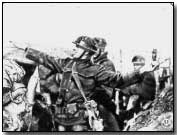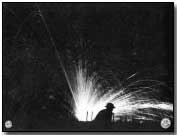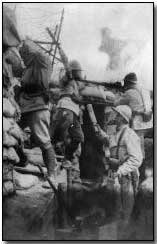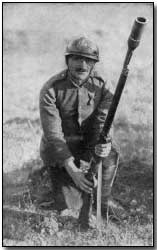Weapons of War - Grenades
 As with numerous weapons significantly developed upon during World War One, the use of grenades
(whose name probably dates from the French word for pomegranate) dated back
some hundreds of years - to the fifteenth century in fact.
As with numerous weapons significantly developed upon during World War One, the use of grenades
(whose name probably dates from the French word for pomegranate) dated back
some hundreds of years - to the fifteenth century in fact.
Grenade Supplies in 1914
Regarded as practical for siege operations only since Napoleonic times however, the grenade came to the attention of German army planners (notable among others) during the Russo-Japanese War of 1904-05.
As with most things at the start of the war in August 1914, the Germans were ahead of the pack in terms of grenade development. Even as war began the Germans had 70,000 hand grenades in readiness, along with a further 106,000 rifle grenades.
Curiously, when many, perhaps most, people are asked to consider the means of trench attack most popular during the First World War, the rifle or bayonet is often suggested as the most likely answer.
Bombing Parties
 In
fact both of these weapons were to be used chiefly to defend the grenadiers:
those men tasked with the bombing of trenches and positions using grenades
of various types. Bombing parties grew in number and frequency as the
war progressed and formed a major component of any infantry attack by the
war's close (although US forces used them less, chiefly on account of
supply shortages).
In
fact both of these weapons were to be used chiefly to defend the grenadiers:
those men tasked with the bombing of trenches and positions using grenades
of various types. Bombing parties grew in number and frequency as the
war progressed and formed a major component of any infantry attack by the
war's close (although US forces used them less, chiefly on account of
supply shortages).
The British bombing team usually consisted of nine men at a time: an NCO, two throwers, two carriers, two bayonet-men to defend the team and two 'spare' men for use when casualties were incurred.
As an attack or raid reached an enemy trench the grenadiers would be responsible for racing down the trench and throwing grenades into each dugout they passed: this invariably succeeded in purging dugouts of their human occupants in an attempt at surrender (often not accepted as they were promptly shot or stabbed).
Not that this was always the case during the war. When Britain entered the war on 4 August it did so with just one type of grenade in its armoury (suitably named 'Mark 1'), and not very many of those. As with the machine gun the British high command could not see much use for the hand grenade.
 This
situation soon changed however; indeed, within a year Britain was producing
up to half a million hand grenades each week (with an average of 250,000).
This
situation soon changed however; indeed, within a year Britain was producing
up to half a million hand grenades each week (with an average of 250,000).
Even so, British forces outside of the Western Front - which was given first call on grenade supplies - were lacking in supplies of grenades until well into 1916.
The French and Russian armies were rather better prepared than the British, since they fully expected to be in the position of besieging German fortresses: a task ideally suited to the grenade.
Two Forms of Detonation
Grenades - either hand or rifle driven - were detonated in one of two ways. They were either detonated on impact (percussion) or via a timed fuse.
Generally speaking, infantrymen preferred timed fuses (of whatever amount of time) to percussion devices, since there remained the constant risk of accidentally jolting a grenade while in a trench and setting off an explosion.
 The
idea of using a pin, extracted by hand from a grenade, to set off a timed
fuse quickly became commonplace and was a feature of most later grenades.
Another, earlier, method of igniting the fuse was via the so-called 'stick'
grenade, where the fuse was lit when the grenade left the handle (stick) to
which it was attached.
The
idea of using a pin, extracted by hand from a grenade, to set off a timed
fuse quickly became commonplace and was a feature of most later grenades.
Another, earlier, method of igniting the fuse was via the so-called 'stick'
grenade, where the fuse was lit when the grenade left the handle (stick) to
which it was attached.
Yet another type, cylindrical and referred to as the 'cricket ball' grenade, was ignited by striking the grenade like a match before it was promptly despatched skywards.
Home-made Grenades
That first British grenade, the Mark 1 used in 1914, proved highly unpopular with soldiers. Forming a canister with a 16-inch cane handle, it was ignited by removing a safety pin through the top. When thrown, the handle (and attached linen streamers) ensured it landed nose down so that the striker was forced into the detonator.
However the Mark 1 caused widespread distrust given that it was liable to explode prematurely if it came into contact with an object while in the act of being thrown: again entirely feasible in a trench environment.
Consequently many British soldiers - and those based in Gallipoli who had no access to grenades of any type - resorted to the construction of home-made, or 'jam-tin' bombs.
 So-named
because they were literally made out of jam tins, each was packed with gun-cotton or
dynamite, together with pieces of scrap metal.
So-named
because they were literally made out of jam tins, each was packed with gun-cotton or
dynamite, together with pieces of scrap metal.
A length of fuse would project through the top of the tin, with each inch of fuse giving approximately 1.25 seconds delay. Other home-made grenades of differing designs were widespread and were seen in various fronts (including in Arabia and in Russia).
Grenade Development
However grenade development soon took off and, at least on the Western Front, ad-hoc types dwindled in numbers as better models appeared.
Rifle grenades were simply attached to a rod and placed down the barrel of a rifle, or instead placed in a cup attached to the barrel, and were launched by the blast of a blank cartridge. Such grenades were never popular however, and were deemed (correctly) as inaccurate. The Germans ceased using rifle grenades in 1916, although they continued to experiment with revised models.
 The
British and French however persisted with cup grenades. The British,
who had pioneered their use, together with the French improved the range of
cup grenades from the average 180-200 metres to an impressive 400 metres
(using fin grenades).
The
British and French however persisted with cup grenades. The British,
who had pioneered their use, together with the French improved the range of
cup grenades from the average 180-200 metres to an impressive 400 metres
(using fin grenades).
The Germans belatedly restarted using cup grenades in 1918.
The first truly popular British hand grenade - simply referred to as 'No. 15' - was churned out in huge numbers by the close of 1915, although its lack of performance in wet weather promptly led to a sharp downturn in its popularity. Whereas up to half a million No, 15's were produced in the autumn of 1915, they were seldom used at all beyond the turn of the year.
The Mills Bomb
There were innumerable types of grenade designed and produced during the war - well over 50 - but one that endured, and which retains a popular awareness even today, is the Mills bomb, designed by William Mills in 1915.
Actually referred to officially as 'No. 5', the Mills bomb was introduced in May 1915 and became the dominant British grenade for the remainder of the war. Weighing 1.25 lb, the Mills bomb's exterior was serrated so that when it detonated it broke into many fragments: thus, a fragmentation bomb.
To use the Mills bomb the thrower first removed the safety pin while holding down the strike lever beneath it. When the grenade was actually thrown the strike lever ejected and a four-second fuse was set off.
 British
and Empire soldiers were instructed to lob the Mills bomb using a throwing
action similar to bowling in cricket. Classes were taught instructing
soldiers how best to do this.
British
and Empire soldiers were instructed to lob the Mills bomb using a throwing
action similar to bowling in cricket. Classes were taught instructing
soldiers how best to do this.
The Mills bomb was improved upon in 1917 with a revised model, No. 36M. This was filled with explosive and then dipped in shellac, which served to seal the grenade and thus prevented rapid deterioration (markedly reducing the number of 'dud', i.e. ineffective, devices). Its base plug was also strengthened, for use on a rifle discharger (when its fuse was lengthened to a seven-second delay).
Transported in boxes of twelve with detonators carried separately, British soldiers found that they could not readily carry multiple Mills bombs on their person on account of their closer fitting uniforms. Their Australian allies, with looser clothing, could carry around half a dozen Mills bombs with reasonable comfort. The British took to carrying green canvas buckets filled with Mills bombs (up to 24 at a time) for use in an attack.
The detonators were supposed to be attached to the actual grenade before the boxes of grenades reached the front line. It was not unknown however for a box of Mills bombs to be opened for use only to discover that they were without their necessary detonators.
It has been estimated that during the course of the war approximately 70 million Mills bombs were thrown by the Allies, with perhaps 35 million other types; a testament to the overwhelming popularity of the Mills bomb itself.
German Models
The German army, having popularised use of the grenade at the start of the war, developed numerous models over the ensuing four years.
 These included the
Stielhandgranate (stick bomb), the Diskushandgranate (disc grenade),
Eierhandgranate (hand grenade) and Kugelhandgranate (ball grenade, which
included the grenade referred to by the British as the 'pineapple grenade').
These included the
Stielhandgranate (stick bomb), the Diskushandgranate (disc grenade),
Eierhandgranate (hand grenade) and Kugelhandgranate (ball grenade, which
included the grenade referred to by the British as the 'pineapple grenade').
With the Germans disliking impact (percussion) grenades as much as the Allies, all bar the disc grenade were activated by a time fuse. Those grenades used by storm troopers utilised the shortest time fuse: a mere two seconds (so that their targets were given no time to seek shelter from the resultant explosion).
The Stielhandgranate - stick grenade - proved highly popular among German soldiers. Some exploded on impact but most were set to detonate after either a 5.5 or 7 second delay. German soldiers often carried such grenades in satchels thrown around their necks.
The Eierhandgranate - egg grenade - was also popular given its great throwing range, up to 50 yards. The German army also made use of gas grenades, containing a poisonous liquid that discharged on impact.
Greatest Grenade Battle of the War
Undoubtedly the greatest grenade battle of the war occurred on the Pozieres Heights on the night of 26-27 July 1916.
Lasting for twelve-and-a-half hours without a break the Australians, with British support, exchanged grenades with their German foes (who threw multiple types of grenade: sticks, cricket balls, egg bombs and rifle grenades). The allied contingent alone threw some 15,000 Mills bombs during the night.
Many grenadiers were killed that night, while many others simply fell down due to complete exhaustion.
World War One and Thereafter...
With the conclusion of World War One the grenade continued to hold its place firmly within the armoury of every nation's army. During World War Two the US alone manufactured some 50 million fragmentation grenades.
Its development has continued to the present day.
Photographs courtesy of Photos of the Great War website
A "creeping barrage" is an artillery bombardment in which a 'curtain' of artillery fire moves toward the enemy ahead of the advancing troops and at the same speed as the troops.
- Did you know?
